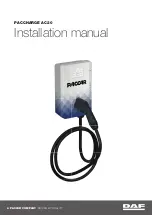
7
STEP 5
CHARGE
LED #4 : YELLOW
4
The CHARGE mode engages if the battery state of charge was 50% or
higher (as tested in STEP 3) or once the battery has been sufficiently
recovered during STEP 4.
The
ampmatic
™ charge current monitoring and control program automatically
determines the most efficient rate of charge current for the connected battery,
according to its state of charge, state of health, and electrical storage capacity.
Maximum charge current: 12V battery => 5A 24V battery => 2.5A The charge voltage
is inversely regulated according to ambient temperature i.e. voltage is increased at
lower temperature, decreased at higher temperature.
Adjustment: -0.04V / cell / °C above or below 20°C (68°F).
STEP 6
OPTIMIZE
LED #5 : YELLOW
5
The OPTIMIZE mode starts when the voltage has reached 14.4V / 28.8V
for the first time during CHARGE mode.
The
ampmatic
™ current control program now delivers pulses of current to equalise
the individual cells within the battery and optimizes charge level.
Charging should complete within the minimum charge time set during STEP 3, but if
the battery requires further charging the program will extend OPTIMIZE mode up to a
maximum of 2 hours.
NOTE: Charge time is usually extended if there is higher than
expected current draw by connected circuitry or battery health is less than optimal.
For safety reasons there is an overall charge time limit of 72 hours for
STEP 4, 5 and 6.
STEP 7
TEST after
charge
LED #6
FLASHING
TEST
6
TEST after charge : Delivery of current to the battery is interrupted for
30 minutes*
to allow the program to determine the battery’s ability
to retain charge.
*
IF the result in STEP 3 was RED (LED #8, indicating a deep discharged battery) the
voltage retention test is extended to 12 hours to confirm battery health.
The TEST result (indicated on LED # 6, 7, 8) is adjusted in real time according to the
measured battery voltage.
Consult the “EARLY WARNING OF BATTERY PROBLEMS” table on page 2 to match TEST
LED indication to an estimated state of charge percentage (SOC%).
More information is provided in the section “NOTES ON TEST RESULTS”.
STEP 8
OptiMATE
smart
MAINTAIN
LED #6 / 7 / 8
ON
TEST
8
7
6
For batteries with a good
state of health LED #6
(green) will remain on.
Exception:
STD wet cell
batteries with filler caps
have a lower fully charged
voltage: LED #6 remains
on together with LED #7.
MAINTENANCE CHARGE:
LED #6 / 7 / 8 steady on
according to final voltage measured at termination of STEP 7.
Float voltage setting: For 12V batteries: 13.6V nominal at 20°C (68°F),
For 24V batteries: 27.2V nominal at 20°C (68°F).
The float voltage is inversely regulated according to ambient temperature; i.e.,
voltage is increased at lower temperature, decreased at higher temperature.
Adjustment: -0.04V / cell / °C above or below 20°C (68°F).
Continuous float maintenance charge will be applied to the battery if the charger
sensed that connected circuitry has a current draw exceeding 200mA, otherwise the
charger proceeds with the standard maintenance mode.
The standard maintenance mode consists of 30 minute float charge periods followed by
and alternating with 30 minute ‘rest’ periods, during which there is no charge delivered.
This “50% duty cycle” prevents loss of electrolyte in sealed batteries and minimizes
gradual loss of water from the electrolyte in batteries with filler caps, and thereby
contributes significantly to optimizing the service life of irregularly or seasonally used
batteries.
During “float charge” a continuous LOW CURRENT PULSE IS DELIVERED TO PREVENT
SULFATION, further extending battery power and life.
If the OptiMate senses the battery has lost charge the program will revert
back to STEP 5 (CHARGE).
TEMP
For accurate temperature regulated charging and long term maintenance place OptiMate as
close as possible to the battery under charge.
For example, if the battery is within an aircraft
stored outside and the OptiMate is used for long term maintenance of the battery, place the charger
























